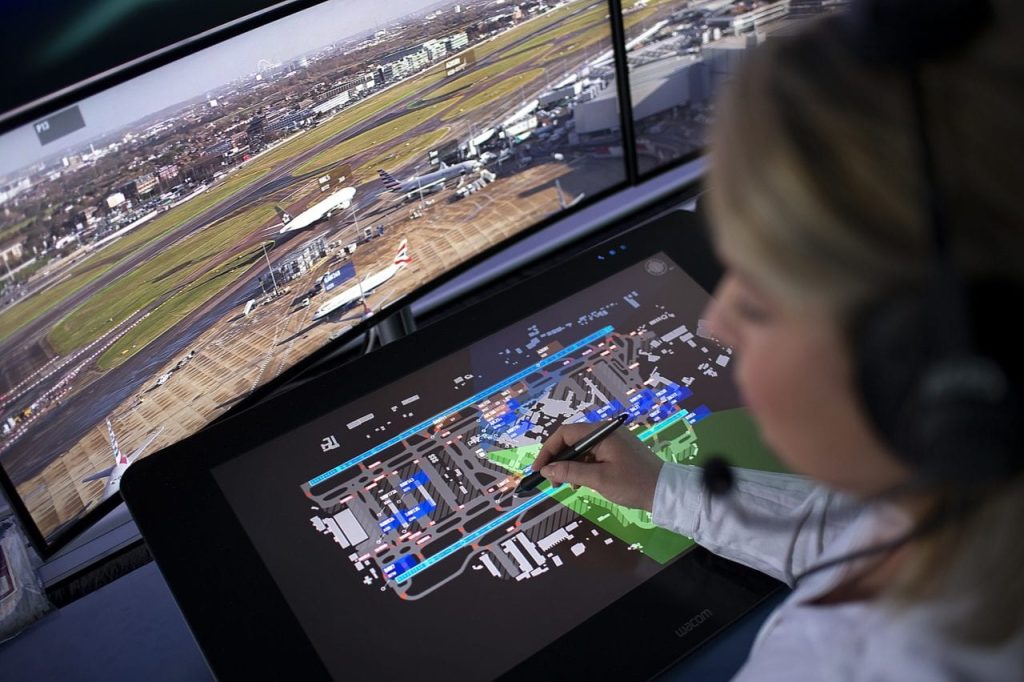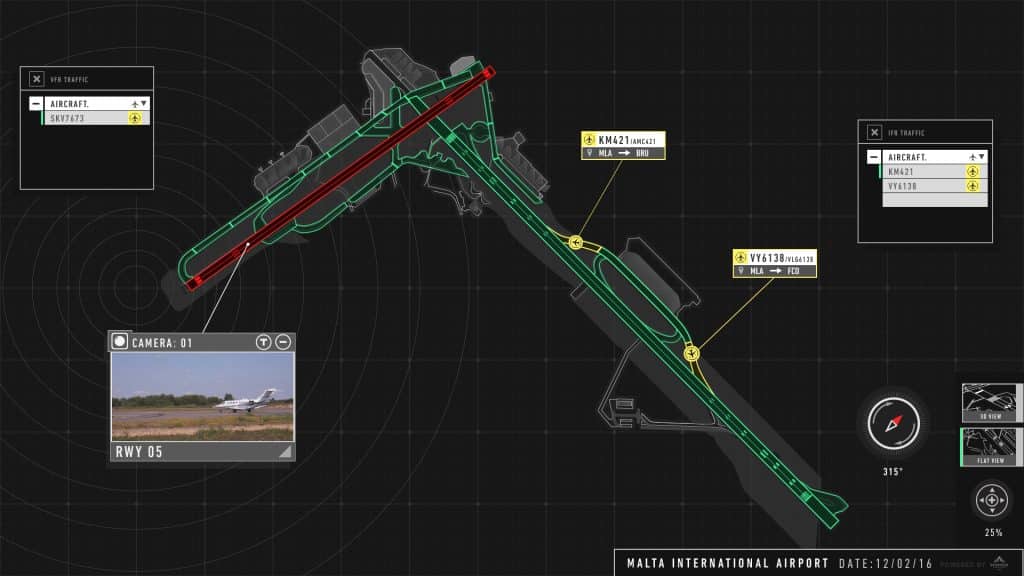Virtual Reality Reducing Airport Congestion
Airports are leveraging the latest technological advancements to improve nearly every aspect of their growing operations, from ticketing and baggage handling to security and customer service. Technology is also allowing airports to improve the flow of aircraft before and after take-off and landing—whether the planes are in sight or not.
Virtual Ramp Control (VRC) uses a mix of cameras, radar, communications, systems, analytics, video walls and other “smart” technologies to provide controllers an unobstructed view of planes, whether they’re waiting at a gate, heading to or from a runway, or are parked out of sight for service.
Virtual Ramp Control (VRC) uses a mix of cameras, radar, communications systems, analytics, video walls and other “smart” technologies to provide controllers and unobstructed view of planes.
Expanding and Enhancing Capabilities
VRC expands the capabilities of a traditional, brick-and-mortar ramp tower by providing intelligent views, coupled with data, in a setting not otherwise possible. Most recognizable is the VRC use of a video wall in lieu of a traditional window. VRC employs the concept of an intelligent “window” view, creating a virtual reality to help controllers “see” around blind spots, buildings or other obstructions, and provides clear images in challenging weather, including fog and blinding snow—capabilities that traditional lines of sight can’t deliver. On top of the enhanced virtual view, the VRC smart window displays useful information gathered and rendered in real time from multiple data sources—appreciably more visual information than a traditional window view provides. And, the video wall can be located anywhere, in spaces that are closer to airport operations and staff. Ramp controllers aren’t isolated in towers and can more readily interact with supervisors and other collaborative staff. The system also carries ergonomic benefits, as ramp controllers aren’t constrained by constantly looking “out” a window and “down” at the ramp. Instead, myriad views are possible, and are more ergonomically displayed on the video wall or on desktops.
Improving the Flow of Aircrafts
While the FAA controls traffic when planes are in the air, taxiing, or taking off or landing on runways, airports typically manage the “ground” control. That responsibility includes aircraft guidance to and from parking at the terminal gates—an area known as the “ramp” or apron. Ramps are extraordinarily busy. There, passengers are boarding or exiting planes, baggage, cargo and supplies are being transferred, ground crews are moving planes into or away from gates, while workers refuel, clean or otherwise interface with planes. Keeping track of all of the activity is no small feat, even at smaller airports. It becomes even more complex with airport terminals serving a mix of domestic and international airlines, narrow-body and wide-body aircraft, and multiple airlines. And, even perched in well-positioned state-of-the-art towers, controllers can’t see everywhere.

VRC employs the concept of an intelligent “window” view, creating a virtual reality to help controllers “see” around blind spots, buildings or other obstructions…
VRC employs an array of strategically placed, high-resolution and infrared cameras, along with surface management and operational data, to pinpoint planes’ exact locations and their associated data. A computer takes that information and displays it as an overlay, in real time, on an expansive wall of high resolution video wall. This not only mimics the view from a traditional control tower, but provides the most relevant data associated with each aircraft at a glance. Just as with traditional towers, the virtual window created by the VRC system allows controllers to make instantaneous decisions based on what they see, which is vital to safely and efficiently maintaining the increasingly packed and puzzle-like flight schedules. It is that non-stop smooth fluid flow experience that passengers, airlines, and the airport all appreciate.

Strategically placed, high-resolution and infrared cameras, along with surface management and operational data, pinpoint planes’ exact locations and their associated data.
Because VRC provides controllers with full visibility wherever they are, airports don’t need to build more towers and occupy expensive real estate to keep up with their increased air traffic. Instead, ground controllers can work from anywhere on—or off—the airport property, without the restrictions of physically occupying elevated towers with a “bird’s-eye” view. Space-constrained airports, especially those in urban areas, can use acreage typically devoted to towers for other uses, or simply provide a more aesthetically appealing terminal.
Aiding Airports of All Sizes
Small airports in remote areas also can benefit from VRC. In Sweden, for example, Saab technology has been installed at some of the country’s most isolated airports, actually providing air traffic control regardless of severe weather and eliminating the need to staff those remote outposts.
VRC systems also capture data that can help identify trends or pinpoint problem areas. For example, it’s anticipated that machine learning analytics can forecast ramp traffic patterns, which for example could alleviate aircraft backups at congested ramps adjacent to runways or in similar scenarios. By helping improve traffic efficiency and safety on the ramps, VRC can simultaneously decrease fuel costs for airlines, improve on-gate times and data for airports, and most importantly provide an enjoyable passenger experience with on-time flights.

Fort Lauderdale-Hollywood International Airport unveiled the first commercial VRC system in the U.S. in 2017. Similar systems are paving the way with United Airlines VRC at George Bush Intercontinental Airport in Houston and work underway for the first large-authority VRC at Orlando International Airport. In addition, VRC is being used at airports in the United Kingdom, Australia, Norway and Ireland, and more airports are expected to soon add the technology, both here and abroad. Burns is working with the Orlando Aviation Authority on a VRC system at Orlando International Airport (MCO) in central Florida. The airport is one of the busiest and fastest-growing in the U.S., and VRC will help the airport take full advantage of a multi-billion-dollar expansion that will add runways, terminals and gates.
VRC is well suited to airports’ seemingly endless pursuit of improvement. Because it is highly scalable, without traditional brick-and-mortar construction, VRC can take advantage of future technologies as airports expand and scale to keep up with passenger demand.
As Orlando International Airport and other locations throughout the U.S. continue evolving, expanding and improving to handle increased air traffic and improve passengers’ experience, VRC will play an increasingly larger role in those improvements, letting airports see well and safely ahead.


